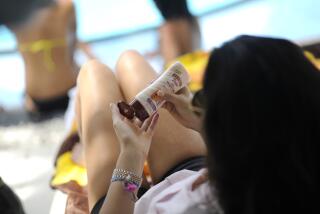Sunscreen Each Day Could Keep the Cancer Away
- Share via
If working on the Great California Tan is still one of your summer pastimes, these are tough statistics to ponder.
This year, nearly a million Americans will find out they have skin cancer.
The luckier ones will have basal cell or squamous cell, highly curable forms if caught early. But more than 40,000 will learn they have the most deadly form of skin cancer: melanoma.
More than 7,000 people will die of melanoma; another 2,200 will die from basal cell or squamous cell.
Sure, sure, you say. You’ll worry about skin cancer later. After all, isn’t it an old folks’ disease? Guess again. The age at diagnosis is sliding south.
In years past, skin cancers were most often diagnosed in people in their 60s and 70s, says Stephen Ullrich, an associate professor of immunology at the M.D. Anderson Cancer Center at the University of Texas, Houston.
Nowadays, it’s not unusual for skin cancer to be diagnosed in people in their 50s or 40s.
But a growing body of research, including a recent study by Ullrich, suggests that faithful application of sunscreen can stem the tide. (Eating a low-fat diet and skin self-exams can also help.)
Writing in this month’s issue of the journal Nature Medicine, Ullrich and his team found that sunscreens “interfere with the mutation at the molecular level that leads to nonmelanoma skin cancer.” (If you think getting your kids to wear sunscreen is a tall order, consider the task of Ullrich’s team: to paint sunscreen on tiny mice before exposing them to artificial light.)
But the sunscreen nearly abolished the frequency of mutations on a tumor suppressor gene. Such mutations, Ullrich says, play an essential role in nonmelanoma skin cancer development in animals and humans. His study was funded by a consortium of European sunscreen manufacturers.
*
Slowly, people seem to be getting the message. Sales of sunscreen and tanning products in food, drug and mass merchandise stores totaled $402.1 million for the 52-week period ending March 30, according to a representative for Information Resources Inc., a Chicago-based marketing research company, up 1.4% from the previous 52-week period. (Sunscreens and tanning lotions are not broken down by category.)
Over the past decade, sunscreen use in the U.S. has increased by 19%, according to an American Academy of Dermatology survey.
Once convinced of the wisdom of sunscreens, you might need a little help when face-to-label with the overflowing sunscreen products shelves. Here’s input from the experts.
Choose a product that protects against both UV-A and UV-B radiation, since studies show both types play a role in skin cancer development. (In the past, skin cancers were blamed exclusively on UV-B and wrinkles tied to UV-A.)
It’s not necessary to buy the more costly name brand.
“Any sunscreen you want with an SPF [sun protection factor] of 15 or higher is fine,” says Dr. John Epstein, a San Francisco dermatologist and clinical professor of dermatology at the UC San Francisco School of Medicine who serves on the photobiology committee of the Skin Cancer Foundation, a New York-based international organization devoted to public education and research.
Now, what about those “waterproof,” “water-resistant,” “sweat-resistant” claims?
Under a proposed ruling on sunscreens, published in the Federal Register in May 1993, the Food and Drug Administration requires formulas labeled as water-resistant to maintain their SPF for 40 minutes of water activity, a representative says. Those labeled waterproof must maintain their SPF for 80 minutes of water activity.
Formulas may be labeled sweat-resistant if they meet at least the requirement for water resistance, according to the FDA.
Some sunscreens are formulated strictly for the face; other formulas for the body. Do you need two types?
It depends, says Dr. Ava Shamban, UCLA assistant clinical professor of dermatology and a Santa Monica dermatologist. “Sunscreens for the body are generally oiler,” she says. If your skin is acne-prone or sensitive, she says, it may be a good idea to choose a facial-only sunscreen, even though they are usually more expensive.
Children’s formulas are often manufactured to sting less, which can be a plus in persuading children to use the products.
More than 125 sunscreen and sun block products have earned the Skin Cancer Foundation “Seal of Recommendation.” To qualify, manufacturers must submit data annually to the foundation. Each year, they must verify that they have not reformulated the product; if they have, they must submit new data. Manufacturers must also join the foundation’s Corporate Council, which carries a $10,000 annual membership fee used to fund the foundation’s public education efforts. (For a list of recommended products, call the foundation at [800] SKIN-490.)
And soon, there may be another option. A sunscreen that contains melanin (the skin pigment that serves as the body’s own defense against the sun) within a patented microsponge system has been developed by Advanced Polymer Systems Inc. in Redwood City, Calif.
The company applied for approval from the FDA in late 1994, says a representative for the company, who can’t predict when the product will go on the market. Called Prozone, it is designed to protect against both UV-A and UV-B exposure.
*
Besides wearing sunscreen, experts say you should know your risk of skin cancers. For years, experts have known that fair-skinned individuals with light eyes and many freckles are at higher risk than others for skin cancer.
Now, a new study published Tuesday in the Journal of the American Medical Assn. has found a quantifiable relationship between the number, size and appearance of moles on the skin and a person’s risk of developing melanoma. Having 10 or more abnormal moles, for instance, increased the risk of melanoma 12-fold.
Eating a low-fat diet might help those at high risk. Dr. John Wolf, chairman of dermatology at Baylor College of Medicine, studied 100 people who had nonmelanoma skin cancers removed. Half ate a diet of about 38% fat; the other half ate a diet of only 20% fat. Total calorie intake was similar in the two groups. Over a two-year period, the number of nonmelanoma skin cancers declined in the low-fat diet group but not in the other group.
Skin self-exams can help too. Stand in front of a mirror; inspect all parts of the body, using a hand mirror. Basal cell cancers usually look like a small, shiny, fleshy nodule on an exposed part of the body, according to the American Academy of Dermatology. Squamous cell cancers typically develop on the face, ears, lips and mouth and often first appear as a red, scaly patch. Melanoma usually appears as a dark brown or black patch with irregular edges. But it can also be multicolored with shades of red, blue or white.
And if you can’t bear to give up the golden look?
Self-tanners have improved since the days they left you with a funny orange cast, a streaked look or both.
But be warned: Even if your fake tans looks like the real thing, don’t forget the sunscreen. Self-tanners, Shamban warns, “don’t provide you with any protection.”
Thursday: New fabrics promise to protect the UV-wary.






